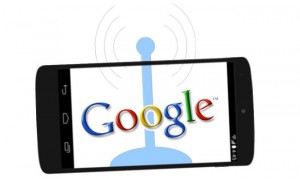The tech giant will be compatible with Bluetooth LE devices and will compete directly with Apple’s device.
Google has now announced its new open-source platform, Eddystone, for devices with Bluetooth LE, and that will make it possible to communicate with other compatible devices such as smartphones.
This will also place the company in direct competition with the iBeacon from Apple.
The Eddystone platform is the latest addition to the geolocation marketplace, which is an integral component to the Internet of Things (IoT) ecosystem. The use of this type of technology could potentially enable a great deal more in terms of contextual services that are available within the actual physical world. The use of beacon tech makes it possible for low-power Bluetooth enabled gadgets to effectively transmit information to smartphones and other similar mobile devices.
Eddystone and other beacons can’t track a smartphone, but the mobile device can detect the beacons.
 Once a smart device has detected a beacon, it is capable of receiving data from it. The user of the mobile device has control over what type of data he or she wants to receive by way of the settings that have been allowed in the apps that have been downloaded. Based on those settings, the smartphone chooses which beacon information will trigger a response within the mobile device.
Once a smart device has detected a beacon, it is capable of receiving data from it. The user of the mobile device has control over what type of data he or she wants to receive by way of the settings that have been allowed in the apps that have been downloaded. Based on those settings, the smartphone chooses which beacon information will trigger a response within the mobile device.
Apple was the very first tech company to step into that form of geolocation and integrate the capability with its iOS 7. At the start, the primary focus for this technology was essentially geared toward retail. Since then, there has been notable growth in the adoption of these beacons among major retailers such as Lord and Taylor’s and Macy’s. Equally, McDonald’s and Starbucks have also used this location based tech in some locations. In the majority of instances, the tech is used to transmit specific promotions, or deals to consumers based on their specific location within a store.
While the outcomes have been mixed, so far, Eddystone is entering into this space at a very early time in its existence and there remains a tremendous amount of potential for innovation, growth and usage.
The University of San Diego’s IT department is using geolocation technology for interactive instruction.
The IT department at the University of San Diego (USD) has recently launched the World Interactive Study Environment (WISE), which uses location based technology to help students to drop pins from wherever they are around the globe, and to add comments, videos, and pictures, in order to encourage greater interaction and discussion among class members.
The pilot of the WISE platform is being run throughout this summer by a 10 student class.
The members of that class will be heading to London as a part of an art history study program. Previously, the platform has already been used in 2015 since its launch, when the location based technology was brought throughout lower income neighborhoods in San Diego by social science students. It was also used by those students for documenting trips that were taken to their local farmers market.
The location based technology is being tested in a number of different contexts and functions.
 The development team behind the WISE platform is now working on creating native iOS and Android versions. Currently, this geolocation technology functions with Google’s Cloud Storage, its App Engine, and its Maps.
The development team behind the WISE platform is now working on creating native iOS and Android versions. Currently, this geolocation technology functions with Google’s Cloud Storage, its App Engine, and its Maps.
The data from the early adopters is integral to the team at the university that is continuing to work on the WISE geolocation platform. They will be collecting the feedback from the pilot programs in order to continue to evolve and enhance it for improved use. They are also considering marketing this platform in order to sell it.
The reason is that there is a nearly endless list of potential learning uses for location based technology, so there is a considerable amount of potential to make money if they are able to sell the tech to the right organization. This is particularly true in the higher education fields, where there is currently a struggle in boosting the interactivity of lessons within the classrooms. The student population is now made up of people who have grown up with the use of digital tools and have a certain expectation as to the types of resources that should be available to them throughout their studies.
 Once a smart device has detected a beacon, it is capable of receiving data from it. The user of the mobile device has control over what type of data he or she wants to receive by way of the settings that have been allowed in the apps that have been downloaded. Based on those settings, the smartphone chooses which beacon information will trigger a response within the mobile device.
Once a smart device has detected a beacon, it is capable of receiving data from it. The user of the mobile device has control over what type of data he or she wants to receive by way of the settings that have been allowed in the apps that have been downloaded. Based on those settings, the smartphone chooses which beacon information will trigger a response within the mobile device.
 The development team behind the WISE platform is now working on creating native iOS and Android versions. Currently, this geolocation technology functions with Google’s Cloud Storage, its App Engine, and its Maps.
The development team behind the WISE platform is now working on creating native iOS and Android versions. Currently, this geolocation technology functions with Google’s Cloud Storage, its App Engine, and its Maps.